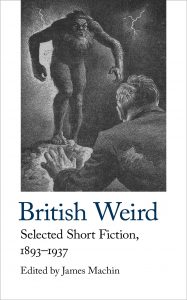British Weird – Selected Short Fiction, 1893-1937 – Edited by James Machin (BOOK REVIEW)
“Has it ever been your fortune, courteous reader [Mr Hampole inquired] to rise in the earliest dawning of a summer day, ere yet the radiant beams of the sun have done more than touch with light the domes and spires of the great city? … If this has been your lot, have you not observed that magic powers have apparently been at work? The accustomed scene has lost its familiar appearance. The houses which you have passed daily, it may be for years, as you have issued forth on your business or on your pleasure, now seem as if you beheld them for the first time. They have suffered a mysterious change, into something rich and strange.”
Arthur Machen, ‘N’ (1934)
“We happen to have camped in a spot where their region touches ours, where the veil between has worn thin’ – horrors! he was using my very own phrase, my actual words – ‘so that they are aware of our being in their neighbourhood.”
Algernon Blackwood, ‘The Willows’ (1907)
 British Weird is a companion volume to Handheld Press’s Women’s Weird and Women’s Weird 2. Whilst the other two anthologies focus on Weird fiction written by women, British Weird concentrates on Weird fiction originating in the UK between 1893 and 1937. This was a fertile and productive time for the genre, with acknowledged masters like Algernon Blackwood, Arthur Machen and Edith Nesbit helping to define the genre. British Weird pulls together nine tales and one essay, including some well-loved Weird classics and some lesser known gems. Editor and Weird fiction scholar James Machin identifies as central to the conception of the Weird tale the fixation on “porous borderlands – literal, spiritual and psychological”, and these stories stand as excellent examples of how the Weird exists in these liminal spaces, and a timely reminder of the power and appeal of the Weird.
British Weird is a companion volume to Handheld Press’s Women’s Weird and Women’s Weird 2. Whilst the other two anthologies focus on Weird fiction written by women, British Weird concentrates on Weird fiction originating in the UK between 1893 and 1937. This was a fertile and productive time for the genre, with acknowledged masters like Algernon Blackwood, Arthur Machen and Edith Nesbit helping to define the genre. British Weird pulls together nine tales and one essay, including some well-loved Weird classics and some lesser known gems. Editor and Weird fiction scholar James Machin identifies as central to the conception of the Weird tale the fixation on “porous borderlands – literal, spiritual and psychological”, and these stories stand as excellent examples of how the Weird exists in these liminal spaces, and a timely reminder of the power and appeal of the Weird.
The collection opens with the striking ‘Man-Size in Marble’ by Edith Nesbit, a tense gothic narrative about walking statues that confirms Nesbit as one of the most underrated of the original voices of the Weird. From the start we are introduced to a narrator who has experienced something outside of their realm of knowable experiences that they and others have begun to question their sanity. He starts off the story by warning the reader about the limits of rationalism. This intersection, between the failure of scientific rationalism to fully capture the experiences of living in the world, and something so outside of experience that it undermines the protagonist’s entire conception of the world, is where the Weird happens.
The stories Machin has selected tend to be situated in the countryside, and the stories here revel in the uncanny of the landscapes they are set in. John Bucchan’s incredible ‘No-Man’s Land’ makes wonderful use of the beautiful yet austere Scottish countryside to portray a menacing encounter between a man and an atavistic, primal fair folk. With its dreamlike sequences of wandering lost among the hills and sudden reversions to brutal physicality, it is powerful and compelling. Algernon Blackwood’s indisputable classic ‘The Willows’ makes incredible use of the isolated stretch of the Danube. With its subtle build up, its inescapable landscape, and the sheer sense of awe of its encounters with the strange, ‘The Willows’ remains a key text of the Weird and has lost none of its numinous, confounding power. John Metcalfe’s ‘The Bad Lands’ imbues a desolate stretch of English countryside with an overpowering sense of dread. ‘Randalls Round’ by Eleanor Scott mines evocative folk horror territory, exploring the sinister meaning behind a curious ritual dance in a small English village.
Other stories feature a horror more closely wrapped up with a single location. E. F. Benson’s ‘Caterpillars’ is a delightfully creepy story about monstrous insects that infest the bedroom of an Italian villa by night, manifesting as a cancer in the victim who sleeps in the room. The story’s nightmarish description of writing giant caterpillars is very effective, especially in conjunction with the more normal proportioned but still uncanny caterpillar that manifests during the daylight hours. It links gothic preoccupations with disease and illness into the more modern mode of the Weird in a way that is striking and effective. L. A. Lewis’ ‘The Lost Keep’ imagines a cursed object that carries with it a pocket dimension, and explores the uncanniness of microscopic vision to great effect, especially in its brutal, Twilight Zone-esque ending.
The remaining two stories abandon the uncanniness of the countryside to find the Weird in an urban setting. Machin makes an excellent choice with ‘N’ to represent essential Weird fiction author Arthur Machen. ‘N’ is a later story of Machen’s, written after Machen had changed his focus from the infernal, as represented by such key works as ‘The Great God Pan’ and ‘The White People’, to the supernal. ‘N’ is uncanny and unsettling, but with a tendency towards transcendence rather than the darkness. The characters in ‘N’ see beyond the veil of reality as we perceive it to a truer reality beneath, but rather than causing madness, death and destruction as this glimpse does in ‘The Great God Pan’, it offers a view of some perfect world we are barred from. Like ‘The Willows’, it demonstrates the sense of awe and wonder and engagement with the numinous that the Weird can provide, and reminds us that this can be just as disturbing and discomforting as an encounter with horror. It is also a gorgeous fractured narrative and a love letter to the city of London in all its forms. Mary Butt’s ‘Mappa Mundi’ does the same with Paris, and just as eloquently and disturbingly paints a picture of a city of dreams that overlaps the real one. Butt’s Paris is imbued with a dark sensuality, which swallows up unwary visitors without leaving a trace. Dense and impressionistic, it rivals Machen’s ‘N’ for the most experimental narrative in the collection.
British Weird is essential for anyone with an academic interest in the Weird. Machin’s introduction wrestles with the perennial question – what exactly IS the Weird? – and manages to unearth new insights and approaches. As is standard for Handheld Press releases, Kate Macdonald’s erudite notes are particularly helpful for untangling the many arcane references that crop up in the stories and separating the obscure from the fictional. The anthology also reprints Mary Butts’ seminal 1933 essay ‘Ghosties and Ghoulies: Uses of the Supernatural in English Fiction’. Butts’ essay is a companion piece to Lovecraft’s essay ‘Supernatural Horror in Literature’ (1927) in terms of being an early attempt to lay out the groundwork for the genre of Weird fiction and define what it is and who was writing it. Butts proves herself as knowledgeable and as passionate about the field as Lovecraft, but in place of Lovecraft’s staunch atheism, Butts acknowledges her belief in the supernatural throughout, making for a more discursive read that throws up fascinating insight into Butts’ beliefs and writing practices whilst serving as a thoroughly in-depth guide to the early days of the genre. The reader will recognise stories and authors not just from British Weird but from Handheld Press’ two Women’s Weird anthologies as well.
British Weird – Selected Short Fiction, 1893-1937 is due for release 30th October 2020 from Handheld Press.


[…] AND if you managed to read this post all the way to the end, here is some bonus content from Jonathan Thornton @ The Fantasy Hive that spiked my interest – British Weird – Selected Short Fiction, 1893-1937 – Edited by James Machin (BOOK REVIEW). […]
Very cool. Thank you for the heads up. i’ll be on the lookout for this since I love weird.